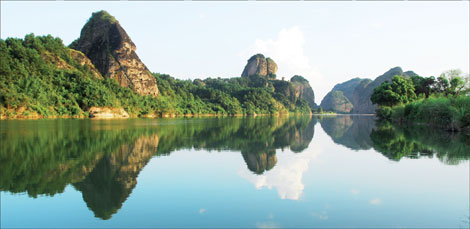On high ground
Updated: 2012-02-03 07:43
By Chen Yingqun (China Daily)
|
|||||||||||
|
Mount Longhu has been hailed as a cradle of Taoism. Xia Chenglin / For China Daily |
Mountain attractions take Chinese beauty to new heights
Surrounded by mountains that reach into the heavens and rivers that flow through mist-shrouded valleys, ancient Chinese artists' efforts to capture the beauty of their homeland culminated in the masterpieces that many today know as Chinese landscape painting.
For fans of these works of art who also want to experience the beauty of nature for themselves, East China's Jiangxi province offers a range of mountains, rivers and waterways that bring an important part of the Chinese aesthetic to life.
In fact, Jiangxi boasts three UNESCO World Heritage attractions for their natural beauty and cultural significance:
1. Lushan National Park
Lushan is in the north of Jiangxi, on the intersection of the Yangtze River and China's great freshwater Poyang Lake.
It was put on the World Heritage List in 1996 for "its aesthetic value and powerful associations with Chinese spiritual and cultural life".
The mountain is famous for its elegant scenery, manifested in the form of peaks that disappear into the clouds, deep and secluded valleys, and awe-inspiring waterfalls.
Five Old Men Peak, about 1,400 meters above sea level, is so named for looking like five old men sitting side by side. The southeast side of the peak sports cliffs with jagged rocks, while the northwest side is covered in lush greenery.
"Climbing to the peaks through zigzag lanes, we get a bird's eye view of the grand Poyang Lake. It's fantastic," says Hu Genhua, a tourist from Jiangxi.
The park is also well-known for its valleys and waterfalls. Sandie Waterfall boasts a 155-meter drop, its water first plunging from the mountaintop onto a huge rock to form a spectacular scene.
For thousands of years the wonders of Lushan have attracted many Chinese spiritual leaders, artists, writers, philosophers and scientists. It has inspired many beautiful Chinese classical poems and also holds great political and spiritual significance in modern China as many historic meetings were held here.
The cultural attractions in the park consist mainly of archaeological sites, inscriptions, historic buildings, and Chinese and foreign villas.
Archaeological sites of farming, hunting and fishing settlements of ancient people are also located here. Inscriptions on cliffs and stone tablets combine the beauty of calligraphy, art and natural wonders.
2. Mount Sanqingshan National Park
Sanqingshan Park is located in the east of Jiangxi province, near Yushan county and the city of Dexing. This resort is famous for its peculiar-looking peaks and strange-looking stone outcrops, beautiful trees and flowers, changing cloud patterns and mists, and smooth-flowing waterfalls.
The park, which covers more than 200 square kilometers, was included in the World Heritage List in 2008 for its exceptional scenic quality and fantastically shaped granite pillars and peaks, most of which resemble human beings and animals.
The peaks, Goddess Sichun and The Python Coming out of the Mountain, are two iconic sights. The Goddess Sichun looks like the silhouette of a maiden with shoulder-length hair. She sits about 1,200 meters above sea level at a relative altitude of 86 meters.
For thousands of years the "goddess" has been watching over the bustling world with a serene look. Locals think she is the incarnation of spring and granted her the name "Sichun", which means taking charge of the spring.
The 128-meter high Python Coming out of the Mountain stands opposite the Goddess Sichun. The top of the peak looks like a python's head with a slightly slimmer body. The granite structure looks like a huge python breaking out of the mountain.
The resort is also home to rare trees thousands of years old and various kinds of exotic flowers. There are different pine trees in the resort, and two of these trees usually grow together, with some even looking like siblings or lovers "growing together".
There are also a great variety of flowers throughout the whole year, with azaleas making up most of the flora.
"In June the hillside comes alive with Rhododendron simiarum. We can smell sweet odors for several kilometers along the azalea valley," says Lin Tao, a local resident.
The changing cloud forms and mists also add to the enchanting beauty of the area.
"When the clouds come together, the whole place becomes a fairyland," says Wang Yanmei, a tourist from neighboring Anhui province.
The park also has numerous waterfalls, lakes and springs. Under the abundant sunshine, rainbows can frequently be spotted around the falls.
3. Mount Longhu
Mount Longhu is located about 20 kilometers southwest of the city of Yingtan in Jiangxi province and has been hailed as a cradle of Taoism. Legend has it that in the Eastern Han Dynasty (AD 25-220), Taoist master Zhang Daoling made pills of immortality in the mountain. When the pills were completed, a dragon and a tiger appeared - giving the mountain its name Mount Longhu (long for dragon and hu for tiger).
Mount Longhu has altogether 99 peaks, 24 cliffs, and 108 natural and cultural sight spots, among which springs and falls are scattered to form a picturesque retreat.
A Taoism museum of more than 3,300 square meters tells the history and of links that help form Chinese culture. Tourists can also visit distinctly Taoist structures such as Tianshi Fu and experience various Taoist cultural forms.
The mountain was jointly put on the World Heritage List with five other areas of China Danxia, a type of landscape formed from red sandstone and characterized by spectacular steep cliffs, in 2008.
Luxi River stretches from the south to the north of the scenic area, and taking a bamboo raft to drift along the river will help travelers appreciate the scenery along the way.
"The graceful peaks are reflected in the clear water, which makes me feel I am in the midst of a painting," says Qiu Jie, 25, from Jiangxi.
The attraction also contains a number of coffins in grottos spread over cliffs. These cliff tombs date back about 2,600 years.

Today's Top News
Rescuers race against time for quake victims
Telecom workers restore links
Coal mine blast kills 18 in Jilin
Intl scholarship puts China on the map
More bird flu patients discharged
Gold loses sheen, but still a safe bet
US 'turns blind eye to human rights'
Telecom workers restore links
Hot Topics
Lunar probe , China growth forecasts, Emission rules get tougher, China seen through 'colored lens', International board,
Editor's Picks

|

|

|

|

|

|






